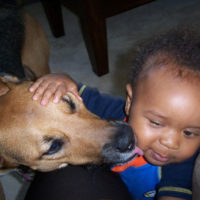What Is the Best Dog for My Kids?

No matter if you’ve had dogs your whole life or you’re considering sharing your home with your first canine friend, this new series of posts by Certified Professional Dog Trainer Barbara Shumannfang, PhD, is sure to provide any dog lover with thoughtful, helpful information.
Our first post explores how to decide which dog to choose for your family, especially if you have kids.
Adding a dog to your family
Have you decided to add a dog to your family? You may be wondering what the best way is to go about it. To be honest, there is no magic formula to ensure you will get the perfect dog. Much about the outcome is not under your control. Life is interesting that way! I think it’s important to acknowledge that in order to take some pressure off you, your dog, and your family. Having said that, I also think your wise efforts before, and after, you choose your dog can stack things in your favor for happy relationships and safety.
With that in mind, look for the following qualities when you visit with doggie candidates you are considering.
Friendliness: Why it’s so important:
- A dog who prefers to be close to children is likeliest to be a safe, fun companion.
- One who voluntarily wants to be in the kids’ space is less likely to take offense when one of them gets on her nerves.
- You’re likelier to bond with a people-oriented dog and therefore help her with training challenges that crop up.
- A dog who loves to connect with people will be a joy to include in family activities.
What does friendliness look like? If your doggie candidate enjoys toys, romps with another dog, or has an adorable appearance, it may look like friendliness because those things make us smile. However…
- The key is to look for a dog who approaches your kids and maintains contact with them.
- Look for loose, open body language and a tail held at spine level or lower.
- Pet the dog and then stop, and have your child do the same. A friendly dog will ask for more by stepping closer.
No matter where you get your dog, friendliness should be the top priority.
Maturity: Ideally your new family dog will be a young adult, about 1-2 years old (or older).
- Parents with young kids usually find it stressful to housetrain a puppy, teach him or her to accept confinement, learn the right things to chew on, and how to sleep through the night.
- It is challenging to teach children to interact gently and safely with a teething, energetic puppy.
- By selecting a more mature dog, you’ll be able to see the dog’s grown-up personality when you meet, making a successful match that much likelier.
Settles down easily: Children have a lot of energy, come and go throughout the day, and have emotional ups and downs. When evaluating a dog, run around, play with a toy, or lavish the dog with excited attention for a couple of minutes. Choose a dog who simmers down when you become quiet.
Attentive to you outside: Interact with the dog outside. If the dog pulls moderately on the leash, training can turn that around. But if the dog fails to check in with you (without you coaxing), tunes you out when you try to get his attention, gets the leash twisted into a spiral, nearly drags you over, or leaps and mouths incessantly, he or she will likely be a challenge to integrate into your family.
Relaxed around other dogs: Picture your new dog walking beside your kids as they tell you about their school day, and imagine how stressful this will be if your dog habitually barks and lunges at other dogs. Arrange a mock leash walk with a helper who will walk one or two different leashed dogs past you to see how your candidate reacts. Whether the barking is out of aggression or frustration, helping a dog overcome this issue takes more time and training than most people wish to invest. Choose from candidates who are more blasé about canine cousins they see coming down the pike.
Not overly possessive of food or toys: Snacks and toys are a normal part of family life, so choose a dog who is not upset by a person approaching or reaching for valued items. While you will coach your child not to do this, it is impossible to always prevent your child and dog from being interested in the same items.
It is risky to assess a dog for possessiveness, since he may escalate quickly from keep-away to a frozen, hunkered body posture, growling, snapping or biting. It is best to get professional assistance with this, or follow the tips in the book Successful Dog Adoption.
Easygoing about everyday situations: An easy going dog will take in stride household routines, play dates and outings. Try to assess how calm or jumpy your candidate is.
- Drop an item like some keys when the dog is looking away.
- Have someone knock and enter wearing a hat or holding an open umbrella.
- Sit quietly and simply hold the dog by the collar for one minute.
Choose a dog who remains nonplussed by these common events.
Consider your children, too: Are they rough-and-tumble or quiet? Do they typically follow instructions or do they have trouble following through? Try to match the personality of the dog such that he can enjoy your kids. If they are well matched, your job will be so much easier, and their friendship will be much likelier to flourish.
After You Bring Your Dog Home…
No matter which dog you choose, be a kid-canine coach. Successful kid-canine coaching requires that you:
1) Guide your child to respectful, kind behavior. That means no approaching the dog when he’s resting or chewing, and no imposing on his space by following him, sitting on him, or hugging him. Dogs may tolerate hugging, but unlike human family members, they rarely like it. Coach your child to play games like fetch and tricks, to read to the dog, and to show affection (when the dog solicits it) by kissing their palm and petting the dog on the chest. (If you find your dog is great and “will let the kids do anything,” read this.)
2) Monitor your dog’s signs of relaxation and tension. Loose, open body language, a partly open mouth, and choosing to be close to your child are good signs. Stiff body language, a tense mouth, or turning away from your child are signs you should separate them. This is Ruff Love. Otherwise your child may learn it’s okay to touch someone who is saying “no.” Your dog may defend himself when his pleas for space go unheeded.
3) Use a Safety Zone when it’s not a good time to coach their interactions.
Choose your dog wisely and be a kid-canine coach, and the friendship between your child and your new family member will be off to a dreamy start.
To blend a dog of any age into your family, see Puppy Savvy: The Pocket Guide to Raising Your Dog Without Going Bonkers. If it’s not yet time to get a dog, have fun with Don’t Lick the Dog in the meantime!
BONUS
The Best Dogs for Kids: Myths and Facts
Myth: It’s better to get a puppy.
Fact: You cannot raise a puppy to have a certain personality. Puppies are no more blank slates when they are born than people are.
Myth: Some dogs are hypoallergenic.
Fact: There is no such thing as a dog who poses no allergy risk. All dogs shed hair and dander, so talk with your doctor before getting a dog.
Myth: Certain breeds are better with kids.
Fact: You can’t judge a book by its cover. Certain personalities are better with kids. Get a friendly dog and teach your child the dos and don’ts.
Myth: Shelter dogs have too much baggage.
Fact: It is possible to get a really great or a really difficult dog or puppy from any source. Carefully assess any dog or puppy you’re considering, no matter the source.
Content is posted from Very Fetching with permission of the author, Barbara Shumannfang, PhD and Certified Professional Dog Trainer. Follow her on Twitter @BarbaraShu_Fang. Contact her at Barbara@VeryFetching.com. Photo by Jabrina Robinson.

